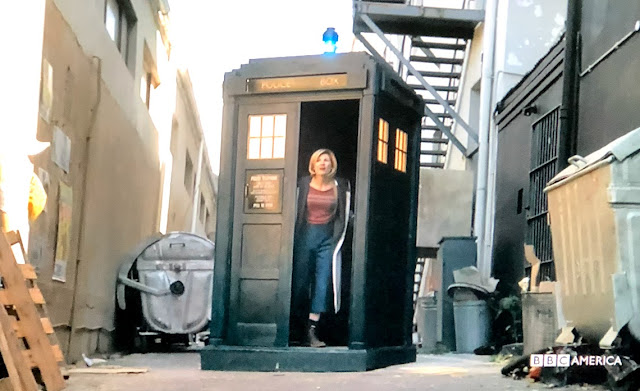Doctor Who is not the only television show to make a time traveling leap back to segregated Alabama. Perhaps one day I'll do a blog post on those Quantum Leap episodes...
Further comments are below.
Doctor Who fandom is massive, which is not surprising since the show has survived so long. If you want to learn a bit, start here
.
The 2018 series brought something new to the Doctor Who universe. For the first time, the good Doctor is played by a woman, Jodie Whittaker. She is the 13th actor to play the lead in the BBC series.
Malorie Blackman is an author of young adult novels and children's books who often uses science fiction settings. Chris Chibnall is currently Doctor Who's showrunner and head writer.
Our episode opens with Rosa boarding through the front door and sitting in the white section of a bus in 1943. She was ordered by the driver James F. Blake to get off and enter from the back door. That same driver will be driving the bus Rosa boards twelve years later.
Rosa reluctantly gets off the bus intending to enter through the back door. As was apparently fairly common in those days, the driver took off before she could get back on.
Doctor Who is an alien Time Lord, so she and her friends make their way around the universe in a time machine, the Tardis, disguised as a British police box. Bradley Walsh, Tosin Cole, and Mandip Gill play the Doctor's newest travelling companions, Graham O'Brien, Ryan Sinclair, and Yasmin Khan, respectively.
They have quickly learned how things are in the segregated U.S. South. Ryan--a black man--is punched for touching a white woman, and Yasmin--a Pakistani--is called a Mexican.
Who and friends set up shop in a motel--fictional as far as I've been able to determine. Ryan and Yasmin must of course remain out of sight. Who and her third friend must pose as a couple to take the room. They have all spent the day of their arrival learning the nature of segregation in Montgomery in 1955. The groups happens to meet Rosa Parks, who sets them straight on some of life's parameters in Alabama.
The group has arrived in Montgomery in 1955 by accident, but decide to stay after detecting another time traveler. The four soon learn he has come to change history by preventing Parks from riding that bus, hopefully preventing the boycott, a major spark of the Civil Rights movement in America.
Why? Well, evil time travelers do that sort of thing. Hey, it's this episode's McGuffin. But rest easy--Doctor Who and companions are going to make sure Rosa boards the right bus.
One of the delights of this episode are the realistic background touches that help recreate Montgomery in 1955. Doctor Who and the others use these bus schedules and phone books to try and locate where Rosa Parks will be on that fateful day.
We also see an ad for the Montgomery Fair department store, the real place where Parks worked as a seamstress. Once the bus boycott began, she was fired from this job.
Here's the Montgomery Fair department store where Rosa Parks worked as a seamstress as depicted in this episode.
And here is the real department store ca. 1940. You can see more photos at the online Department Store Museum.
Parks was living in unit 634 of the Cleveland Heights Apartments when the boycott began.
Doctor Who and Rosa meet again.
The black man among Doctor Who's companions, Ryan Sinclair, makes his way to Rosa Parks's apartment where she is meeting with Martin Luther King Jr., and attorney Fred Gray.
A determined Rosa takes her seat in the white section of the bus.
She refuses to move, the driver calls the police, and Rosa is arrested. History is not interrupted.
Back aboard the Tardis, Doctor Who winds up the episode with a rousing explanation of what happened next in the Civil Rights movement.
The episode ends with Doctor Who and friends viewing the asteroid named after Rosa Parks.
"Rosa" is not a documentary, and some liberties are taken with historical reality. But as this article notes, "Rosa" is remarkably accurate for an episode of a weekly fantasy series.




























































